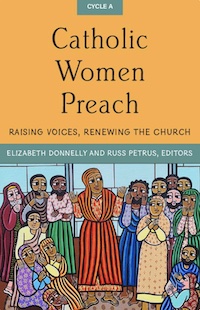Breaking the Silence by Julie A. Ferraro
 Catholic Women Preach:
Catholic Women Preach:
Raising Voices, Renewing the Church
Edited by Elizabeth Donnelly and Russ Petrus
Orbis Books, 2022
$20 296 pp.
In late January, while speaking to a group of diocesan liturgical directors, Pope Francis mentioned that homilies should be kept under 10 minutes and deal with real life as lived by those in the pews.
Weeks prior to that, this volume—Catholic Women Preach—had been published.
The book—the first in a set of three for Lectionary cycles A, B, and C—features a homily for each Sunday of the liturgical year, beginning with Advent, along with selected solemnities such as Our Lady of Guadalupe, the Feast of the Presentation, and All Saints. All were written by women.
The contributors range from laywomen with master of divinity degrees to vowed religious from many communities. Their biographies are included at the end of the book and reveal a rich, collective background in spirituality and theology as well as activism.
As Dominican Sister Barbara E. Reid begins in her foreword, “Among all the various ministries, there is none more crucial than the ministry of the Word.” That women’s voices have been so long silenced when it comes to this ministry is a travesty, which the editors seek to remedy.
They are joined by board members of FutureChurch, who began the “Unheard Homilies” project in 2001 as a way to share valuable insights into scriptures from those who live the tenets Jesus taught in more tangible ways than those who are ordained.
None of the homilies are more than six pages in length, yet the power of the stories that are related hit home, touch the heart, and fire the soul.
“How often have we failed to recognize him in the forgiveness of a friend, the hug of a child, a physician’s healing touch?” asks Sister Anita P. Baird of the Religious Congregation of the Society of the Daughters of the Heart of Mary in her homily for the Third Sunday of Easter. She adds yet another question: “How many times in our self-absorption or pity party have we been prevented from recognizing him?”
Priests don’t preach like this. They seldom, if ever, use such down-to-earth and practical language.
Being a mother and grandmother, the hugs of my sons and grandchildren hold deep and significant meaning for me. Hovering in the emergency room while a nervous youngster tries to remain still while a doctor sutures a gash from a nasty fall, the appreciation for such services is profound.
I have lived in an intentional community with vowed Franciscan Sisters. In the absence of a resident chaplain, they would hold weekday communion services, integrated with morning praise. Though I have no advanced degrees of any kind, I was permitted to join the rotation, sharing my reflections on a particular day’s gospel—making sure they were brief, relatable, and tinged with humor. The sisters received insights into the life of a laywoman, as I benefitted from hearing about their ministries and how they brought Christ to those being served.
The ordinary becomes extraordinary in these pages. For the 17th Sunday in Ordinary Time, psychologist Maria Teresa Gaston reflects on preparing to sell a house where she’d lived for 17 years. She writes of the stress and pain of that process.
Mercy Sister Patricia Smith faces the dilemma of creating a homily for the 32nd Sunday in Ordinary Time, where the gospel reading (Matt 25:1-13) features women who are portrayed as “ditzy and not very responsible.” She goes on to explain how girls of 12 or 13 in Jesus’s time attended a bride, and how those for whom Matthew wrote his gospel were intended to receive the parable. Practicality is blended with history and wisdom.
Whether retired scholars or even deceased lecturers like Francine Cardman of Boston College’s School of Theology and Ministry, the thoughts of these women on the readings heard from the pulpit are more than worthy to be shared with congregations eager to find tangible truth and sustenance for daily living in the homily. There are some entries that feature terms and concepts where those in the pews might need to consult a dictionary to fully grasp them, such as “eschatological” in the homily for the Transfiguration by professor emerita of the University of Notre Dame Mary Rose D’Angelo.
To conclude with Sister Barbara E. Reid, citing the Rule of St. Benedict: “As you listen with the ear of your heart to the wisdom of women, may you, too, be emboldened to preach the word with persistence at all times and in all ways.”
This book, and its forthcoming companion volumes, will make that possible in ways the male clergy don’t seem to grasp. ♦
Julie A. Ferraro has been a journalist for over 30 years, covering diverse beats for secular newspapers as well as writing for many Catholic publications. A mother and grandmother, she currently lives in Atchison, Kansas. Her column, “God ‘n Life,” appears regularly in Today’s American Catholic.





Leave a Reply
Want to join the discussion?Feel free to contribute!